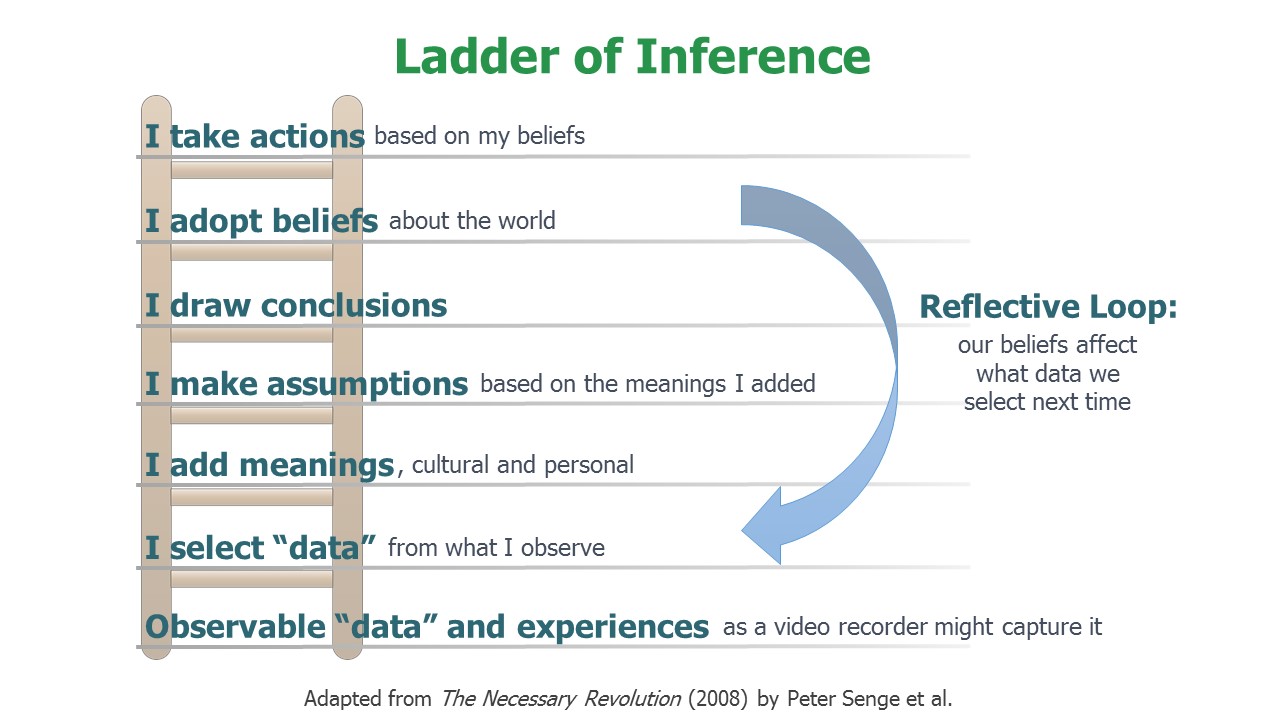I recently finished reading The Necessary Revolution: How Individuals And Organizations Are Working Together to Create a Sustainable World, by Peter Senge, Bryan Smith, Nina Kruschwitz, Joe Laur and Sara Schley Nicholas Brealey. I highly recommend this book to anyone working in sustainability / corporate responsibility. It provides practical tools to help professionals think about the challenges and opportunities presented in this field. The book made me think deeply about mental models and how our assumptions about the systems we live in affect our ability to see opportunities, understand risks, and think critically about the solutions we come up with.
For example, one of the ideas explained in the book is called the Ladder of Inference. The authors explain that the Ladder of Inference is the process by which we add meaning and draw conclusions about the world around us. It shapes the way we select data from our experiences, add meaning to the selected data, and make assumptions and conclusions according to these meanings. Ultimately, these conclusions shape our beliefs about the world. This process is cyclical; the beliefs we currently hold affect the data we select for analysis in the future.
The Ladder of Inference can have significant impact on the effectiveness and ability of organizations to find solutions to problems or make decisions. In The Necessary Revolution, the authors state, “When teams or working groups get stuck in unproductive conversations, you can be sure that it is because members have moved up their ladders of inference and cannot get back down”. Sticking to your assumptions about the current situation is understandable; yet, as the authors argue, this can be a “primary reason why differences of view become embedded conflict rather than opportunities for learning”.
Instead of staying high up the ladder, teams should look critically at the assumptions in each proposed solution to further explore their validity. What happens if the assumptions are incorrect or changed? Through this process, groups can better analyze the major elements of potential risk and uncertainty in the proposal.
The authors state, “By suspending assumptions, we recognize inferences we are making and then seek more data to confirm or refute them”. They argue that the point is not necessarily to prove or disprove these assumptions; indeed, in many cases this may not be possible. However, “the discipline of testing our assumptions forces us to make them explicit, opens the possibility that they might not be 100 percent correct, and lays the foundation for learning over time”.
While these actions may be common in conflict situations – where C-suite executives or managers disagree on a course of action – this sort of analysis can also be translated to situations where all parties agree on the strategy to take given that their beliefs or worldviews on the topic align. In many non-profit or advocacy organizations, for example, people tend to have similar beliefs about the topic they are dedicated to. This can cause differing opinions, based on opposing data and worldviews, to be completely left out of the debate. Just because there is wide consensus on the topic does not mean that the inferences and assumptions used to make that decision are sound.
Looking critically at the beliefs and assumptions we use in our analysis is an exercise we should do more often, whether we are agreeing with a group of like-minded colleagues or debating the opposition. I know I have fallen into the trap – or rather, climbed up the ladder – many times myself.
Image Credit: Amy Blyth
